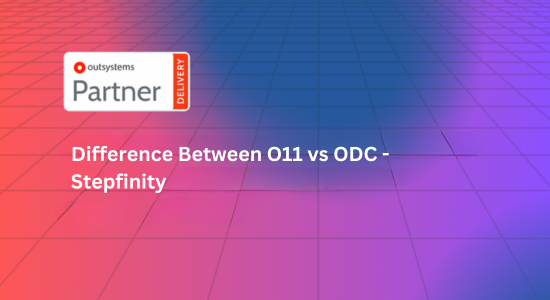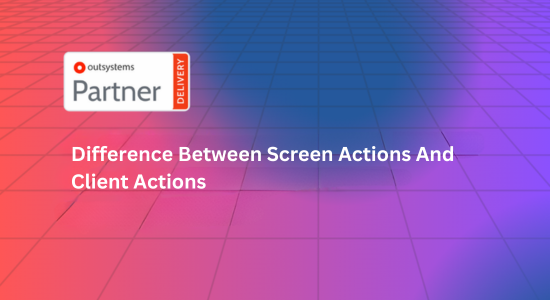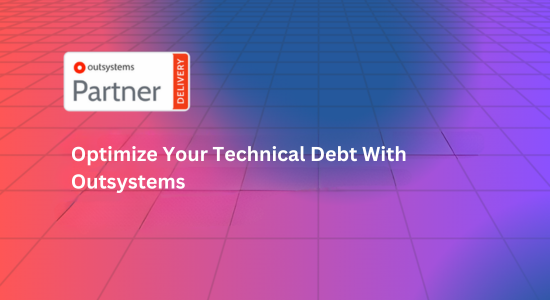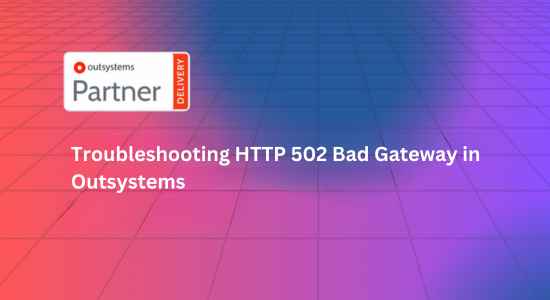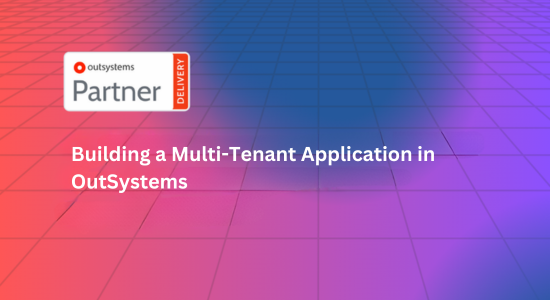Preparing for Client interview or company’s interview?
Or studying on Outsystems?
Or simply doing some research to decide, which platform you should choose for your next project.
Difference between Outsystems 11 and ODC is a question which can always a stumbling block on your road.
But no worry, we got you.
In this article, we will tell you everything you need to know about Outsystems 11 and ODC, and major differences between O11 and ODC.
What is Outsystems O11
Outsystems O11, also known as Outsystems 11 is a version of Outsystems platform. Outsystem is a low code platform which helps it’s user in fast applications development and deployment of those applications. It let developers to build reactive web applications, as well as mobile application with minimal coding efforts.
Outsystem 11 applications are very scalable, secure and maintainable. They not only make development of applications easier for developers but also helps them to avoid basic syntax errors normally occurred during writing traditional programming based codes .
So the developer focus more on features of the applications than building some classes and objects.
Importance of O11
1. Faster Application Development:-
Outsystems 11 helps developers to build large application with minimal efforts in coding because it is a low code platform which let developers focus on the logics and features of the application. As writing code is as easy as dragging and dropping something, with it’s drag and drop functionality.
2. Enterprise-Grade Architecture:-
Enterprise Grade Architecture is a process of designing a strong, scalable and reliable system for large organization’s working. It ensures these systems can handle the complex business needs and evolving technology landscapes.
Outsystems 11 can create an Enterprise Grade Architecture based system as it supports microservices, APIs (Application Programming Interface), modular architecture, which can help the developer to create a scalable and secure application.
3. Modernization of Legacy Systems:-
Legacy systems are the old and outdated software, hardware and technology which is still in use, mainly because of their critical uses in the businesses industry, but they are now creating problems because of lack of modern features, security and difficult in integration or replacement.
While Outsytems 11 helps to integrate with legacy system seamlessly to make sure it is better, giving business chances to modernize their IT infrstructure.
4. Cross-Platform Compatibility:-
Outsystem allows user to develop web reactive applications as well as native mobile application for both Android as well as IOS platform on the same code base.
It not only provides freedom to developer to launch their application where-ever they want and also saves them extra efforts of coding on different platforms.
5. Security and Compliance:-
Outsystems 11 have in-built security feature to make application developed in Outsystems more secure with less efforts. The main security feature includes secure authentication and role-based access control.
Secure Authentication :- Outsystems allows six distinct authentication method, they are Internal, Active Directory, LDAP (Lightweight Directory Access Protocol), SAML 2.0 (Security Assertion Markup Language), Microsoft Entra and Okta. By default the authentication method is that the information of the end user is stored in Outsytems database.
Role-Based Access Control (RBAC) :- By this feature a developer can decide which part of the application should be restricted for specified roles while others doesn’t require any role-based access, with just one click.
5. Extensibility with Custom Code:-
Outsystems is an open platform which is still developing. But its lack of features don’t hamper development as Outsystems enables the developer to extend the Outsystems functionality, while adding Javascript code, C# resource file or by using other custom integrations.
6. AI-Assisted Development:-
With AI – Assistance developer gets valuable suggestion while writing the code, so the amazing way which just clicked on there mind don’t slipped through the process of finding right elements to write the code.
Advantages and Disadvantages of O11
Advantages
1. Hybrid Deployment:
O11 offers flexible deployment options like cloud, on-premises, or hybrid. It gives more freedom to the organization to decide where their apps should be hosted.
2. Enterprise-Grade:
O11 supports large, enterprise-scale applications with deep integration with existing systems like ERP, CRM, databases, etc.
3. Full Flexibility:
O11 is capable of handling complex business logics, rich front-ends design, backend processing, and custom development using various technologies like C#, .NET. It allow developers to use plug-in for mobile application, so the application can be developed according to the modern market.
4. Extensive Ecosystem:
O11 is mature platform with a well-established ecosystem of templates, plugins, and community resources, which helps speed up development, as the developer doesn’t have to develop an application from the scratch.
5. Legacy System Integration:
O11 provides excellent support for integrating with traditional enterprise systems like SAP, Oracle, SQL Server, and custom backends, making it suitable for organizations with legacy infrastructure.
6. Security:
O11 offers strong and safe security features suitable for complex enterprise needs, with customizable security configurations, access control, and encryption.
7. Proven for Large Projects:
Proven platform for large-scale, mission-critical applications that require both performance and reliability. Today O11 is proved to the a saving grace for developer, who wanted to create a large project fast and with minimal efforts.
Disadvantages
1. Infrastructure Management:
O11 needs to manage infrastructures, patches, updates, and maintenance, especially for on-prem or hybrid deployments.
2. Steeper Learning Curve:
While O11 is a powerful platform, its comprehensive feature set and flexibility mean that O11 can have a steeper learning curve, especially for new developers, which can cause a road block on there journey for development in the field.
It can also be a reason that in future freshers refuse to get along with Outsystems on initial stages.
3. Less Optimized for Microservices:
Not as optimized for microservices-based architectures or modular applications when compared to cloud-native solutions as developer have to put lot of efforts for the integration of all the modules.
4. Heavier for Cloud-Native Development:
While flexible, O11 is not as lightweight or tailored for cloud-native application as compared to ODC.
What is ODC
ODC stands for Outsystems Developer Cloud. As the name suggest, this is a cloud-native low-code platform which is designed to help businesses develop scalable, secure and efficiently performing application integrated with modern cloud technologies.
In other words we can say that ODC is crucial for **enterprises who are looking forward to modernize their IT infrastructure** and ready to use **cloud-native** technologies without sacrificing the **speed of low-code development**.
ODC is build on a microservices architecture and is fully optimized for Kubernetes, containers and serverless computing.
In ODC the type of reusable elements will be a little different. There are only two types of reusable element.
* App
* Library
Important things about App
– An App can have all kinds of different elements, including Entities.
– Entities can be exposed as read-only. If you need to update a record in an entity you will need to do so by exposing a Service Action with the logic to update your record.
– Although Apps can have web blocks, they cannot be exposed as public.
#### Important things about Library
– A Library can contain only certain types of elements.
– One element type a Library cannot contain is Entities.
– A Library cannot interact with normal Entities. For example, it cannot have a Server Action that updates a record.
– A Library can only consume elements from other Libraries or consume external REST APIs.
– A Library should only have reusable UI elements and actions that do not interact directly with the database.
Importance of ODC
1. Better scalability :-
ODC helps to provide better scalability of in demands application because its data is stored cloud-server. It uses containerization approach to make the application scale automatically based on the workload demand, without any manual intervention. Making it easier to manage the application during peak usage or on high demand.
2. Lower operational costs :-
ODC when uses containerization approach and serverless computing, it helps to optimize cost of cloud by only using resources which are needed. So the business only pay for what they use unlike traditional techniques of maintaining the whole infrastructure. It also reduces wasteful resource allocation, saving overall lot of cost of cloud hosting.
3. Increased developer productivity :-
With automated integration and many other features, ODC increases developer’s productivity as they don’t have to work on these essential but repetitive tasks which help them focus on making logic and new features for their project.
In other words we can say that ODC saves alot of developers time, so they can focus on other important things about projects.
4. Cloud-Native Architecture :-
Unlike traditional Outsystems platform which is O11, ODC (Outsystems Developer Cloud) is natively build in cloud infrastructure. In other words we can say that applications of ODC run on fully maintained cloud infrastructure, removing the requirement of maintaining complex and heavy personal infrastructures.
Due to cloud native architecture, ODC’s application is very flexible and cost efficient as they consume resources based on demand, which eliminates the risk of having unused resources.
5. Enhanced Security & Compliance :-
Security is the major concern for the businesses as it can make or brake the brand. And ODC comes with so many security build in features that help the developers to make the application secure effortlessly.
For examples, ODC have automated security updates, built-in **identity and access management (IAM)** which ensure that the user is eligible to access the places they are trying to access, which can be changed by the admin, it also have encryption by default to keep the business sensitive data secure.
6. Multi-Tenancy Support :-
ODC helps the business to run their application in multi-tenant environment, which means it allows multiple users to use the same application’s instance (a copy) while keeping data separate of each customers.
Multi-Tenancy is helpful in many aspects like, it makes deployment of the updates on all tenants easy and effective. Also it helps reducing the cost for SaaS business and enterprises application.
Advantages and Disadvantages of ODC
Advantages
1. Cloud-Native Architecture:
ODC is built on a cloud-native architecture (Kubernetes, microservices)due to which it is ideal for scalable, modern, and distributed applications. It is used for auto-scaling and self-healing capabilities through Kubernetes.
2. SaaS Model:
ODc is fully managed by OutSystems, removing the need for infrastructure maintenance, setup, and upgrades. Which saves lot of the enterprise.
3. Strong DevOps & CI/CD Integration:
ODC is built while focusing on DevOps and Continuous Integration/Continuous Delivery (CI/CD) pipelines, making it easier to automate deployments and updates of the application.
4. Faster Time-to-Market:
ODC simplified, cloud-focused environment and also reduces development complexity by enabling faster prototyping and deployment of applications. So that the enterprise can deploy the updates on regular basis.
5. Modern Tools Integration:
ODC provides the experience of better integration with cloud-native services like AWS, Azure, GCP and modern development tools for example Node.js, JavaScript. etc.
6. Security & Compliance:
ODC comes with built-in, modern cloud security practices (OAuth2, SSO, etc.) and compliance features tailored for cloud environments. Other than that ODC also provide some built-in in security features like Role Based Access Control
7. Best for Modular and Microservices Apps:
ODC is designed to support cloud-based, modular, and microservices-driven applications, which is ideal to handle large organizations data and also helps organizations adopt a flexible architecture.
Disadvantages
1. Less Control over Infrastructure:
Since ODC is fully SaaS based platform, organizations have less control over infrastructure decisions, customization, or where their applications are physically hosted. Which can cause a sense of dissatisfaction to some clients.
2. Limited to Cloud:
ODC is exclusively cloud-based platform which means it’s not an option for organizations with on-premises infrastructure or strict regulatory requirements that demand on-prem solutions.
3. Less Mature Ecosystem:
The ecosystem, including templates, plugins, and community resources, is still developing and might not be as extensive as O11.Which can hamper the development sometimes, or can leads to lot of time for researching on a basic task
4. Limited Support for Legacy Systems:
While it integrates well with modern cloud platforms, it may not be as comprehensive when integrating with legacy or traditional enterprise systems, which are crucial for the enterprises. Even when legacy system is outdated and doesn’t have modern features but most of the businesses are still depended on them.
Difference between O11 and ODC
* Architecture :-
O11 :- O11 works on modular basis which means every application can have lots of modules so they can create logical architecture based applications. While O11 supports microservices, but it not fully cloud-native.
ODC :- ODC don’t work on modular basis, in other words each application have only one module, unlike O11. While ODC is fully cloud-native, which means it is built for microservices and containers.
* Deployment Model :-
O11 :- There are mainly three deployment models available in O11. They are On-Premises, Private Cloud and Public Cloud. Which give liberty to the enterprise to choose which deployment model will be best for them.
ODC :- On the other hand, ODC is fully cloud-native based, which means there is no other option for enterprise than to adapt public cloud deployment only.
* Scalability :-
O11 :- O11 is mainly based on traditional infrastructure because of which it has limited scalability, and enterprise needs to maintain their application in the way which can bear enough traffic and demand.
ODC :- While if we talk about ODC, then there is no need to maintain infrastructure, because of which it is more scalable.
* Technology Stack :-
O11 :- O11 is based on the technologies like .NET, and also supports Javascript and C#, even developer can extend features of Outsystems with the help of Javascript.
ODC :- While ODC is based on cloud-native, containerized and serverless architecture.
* Code repository
O11 :- In O11, you have a code repository per environment (Development, Test, and Production). This means you need to rebuild each time you deploy to a new environment which can be time consuming as well as less effective.
ODC :- In ODC, you promote the version in the registry without recompilation when you promote your app to the next stage which is more effective and less time consuming.
* Custom Code Extensions And Forge Components :-
O11 :- In O11 your code was hosted and executed directly on the server where your code was also running.
ODC :- In ODC, all your custom code extensions (like C#) will run using AWS Lambda. This means that your code will run in a serverless service, which will be accessed through a REST API, and not in your application container. In other words, your custom code will follow the principle of FaaS (Function as a Service).
So this article is mainly concentrated on all the basic knowledge about O11 and ODC and their major differences. So after all the analysis, we can conclude that :-
– **OutSystems 11** is best for companies who wants to work on on-premises, hybrid, or traditional cloud setups, as O11 supports legacy system and easy integration.
– While **ODC** is ideal for businesses looking for **fully cloud-native**, scalable, and serverless architectures with minimal maintenance and it also have advance features like multi-tenancy, etc.

